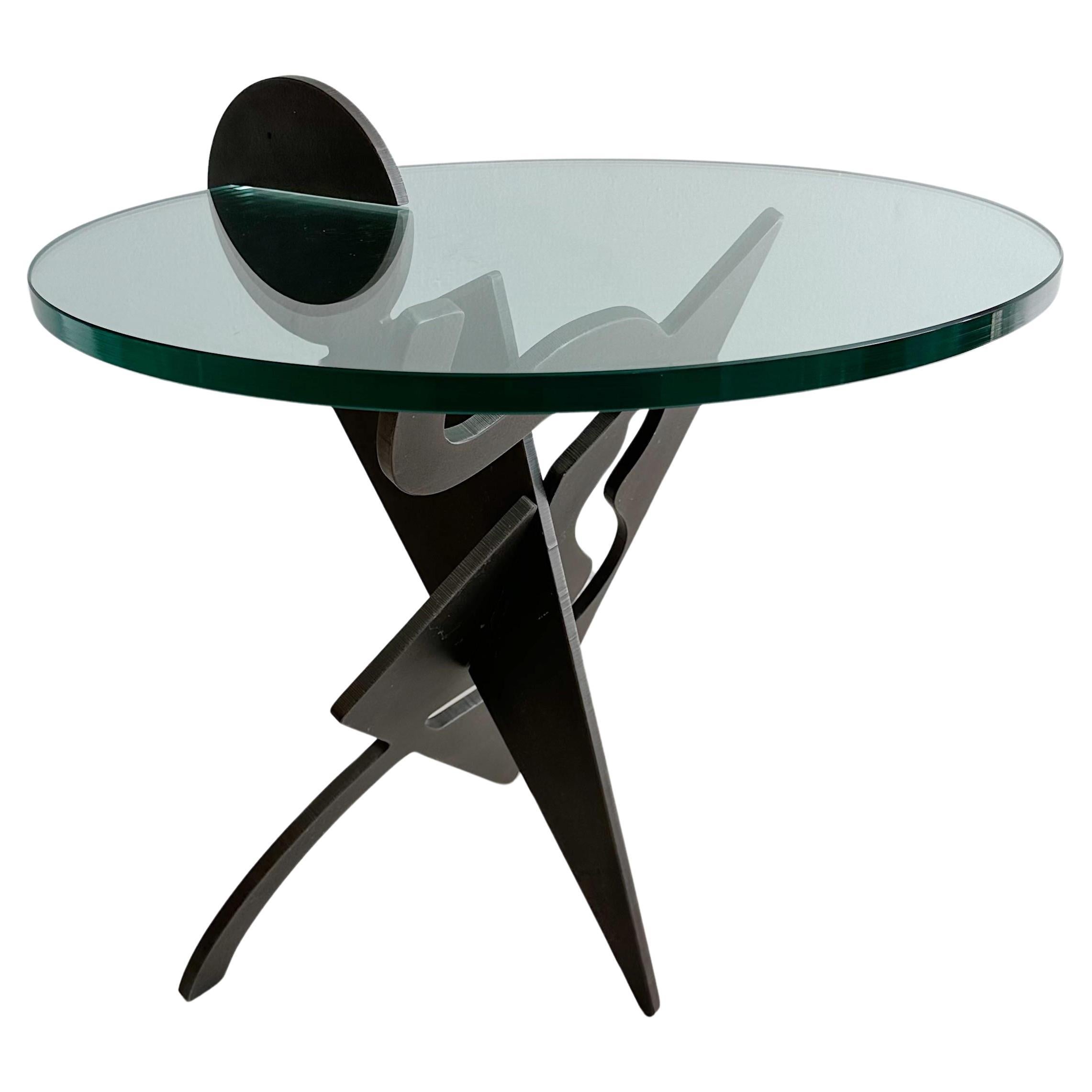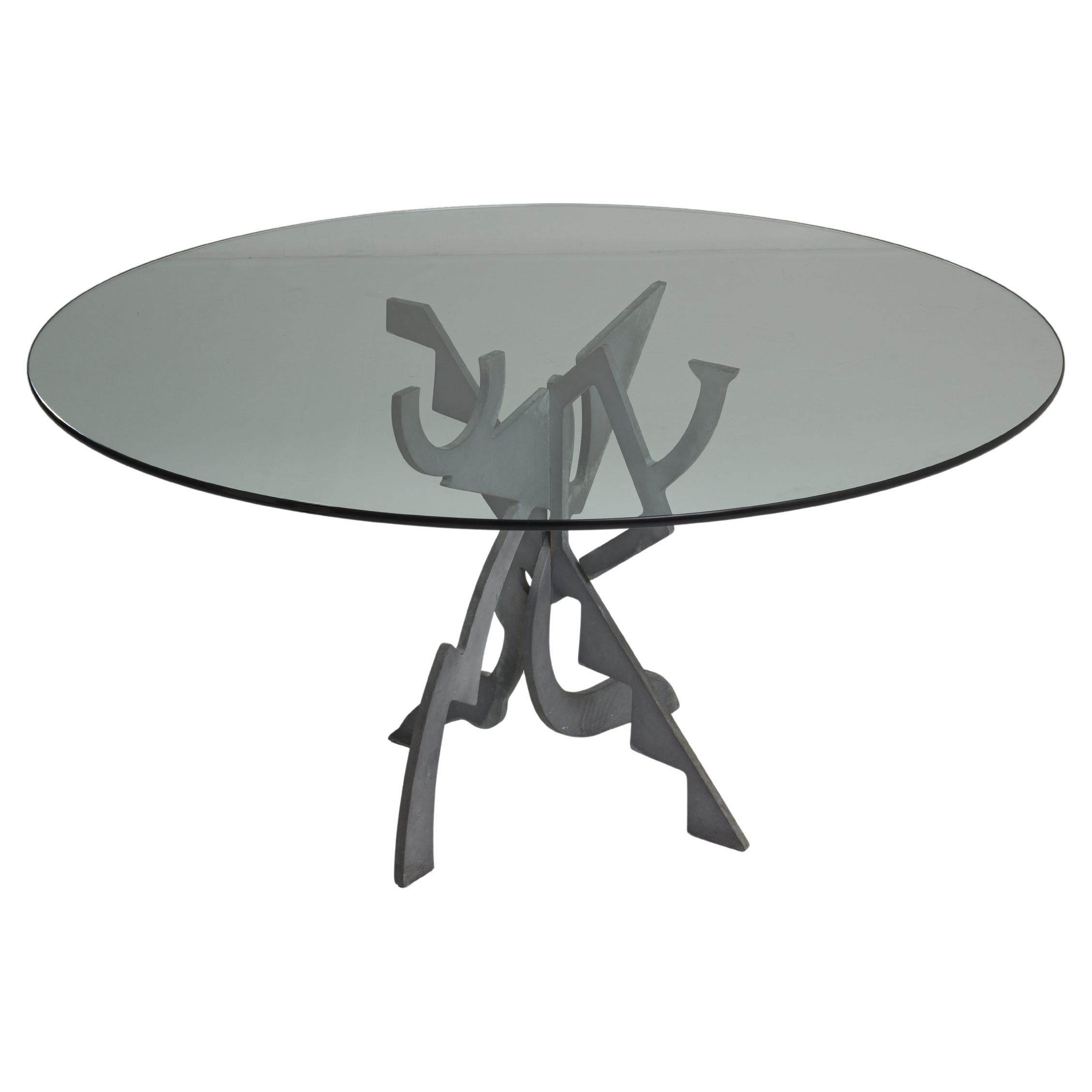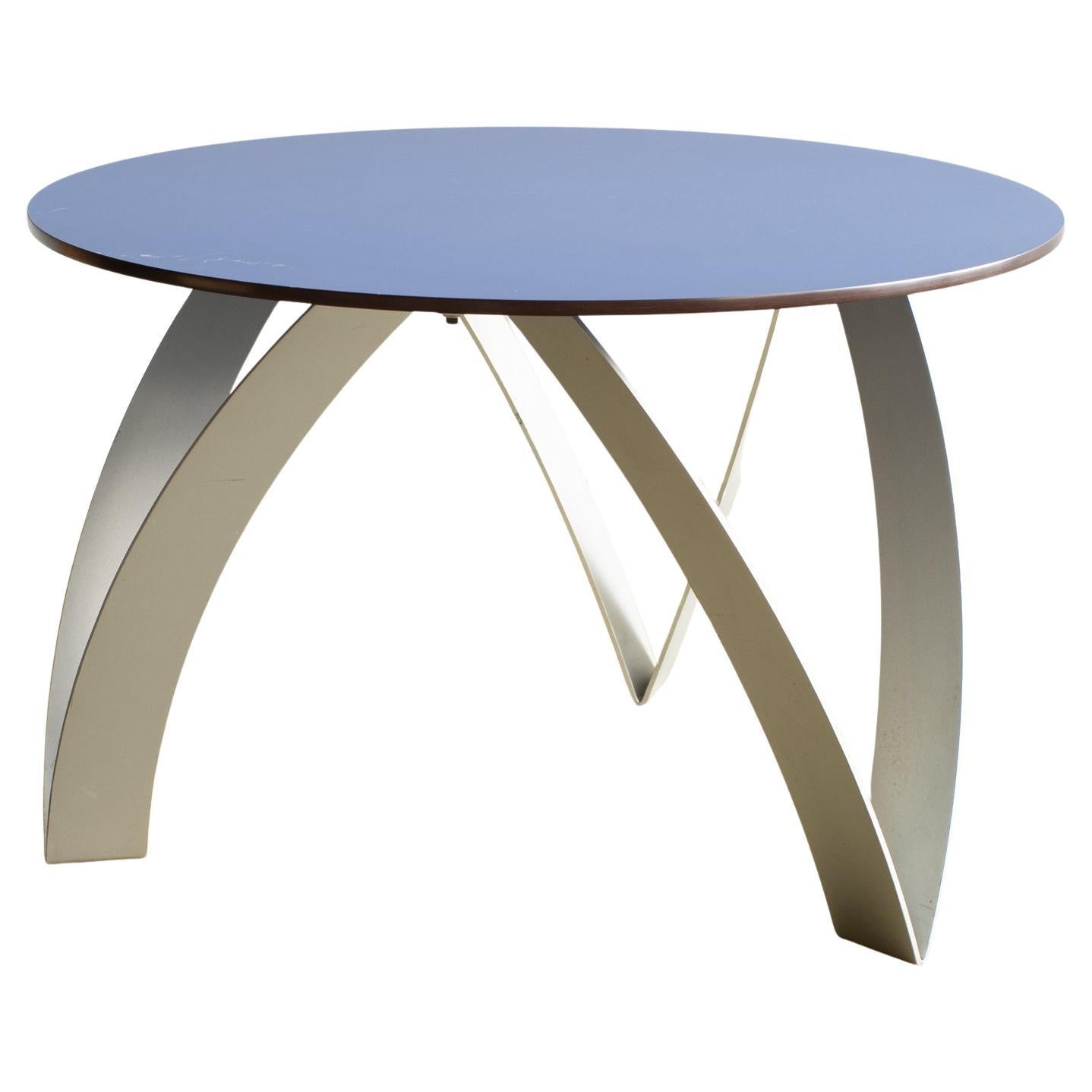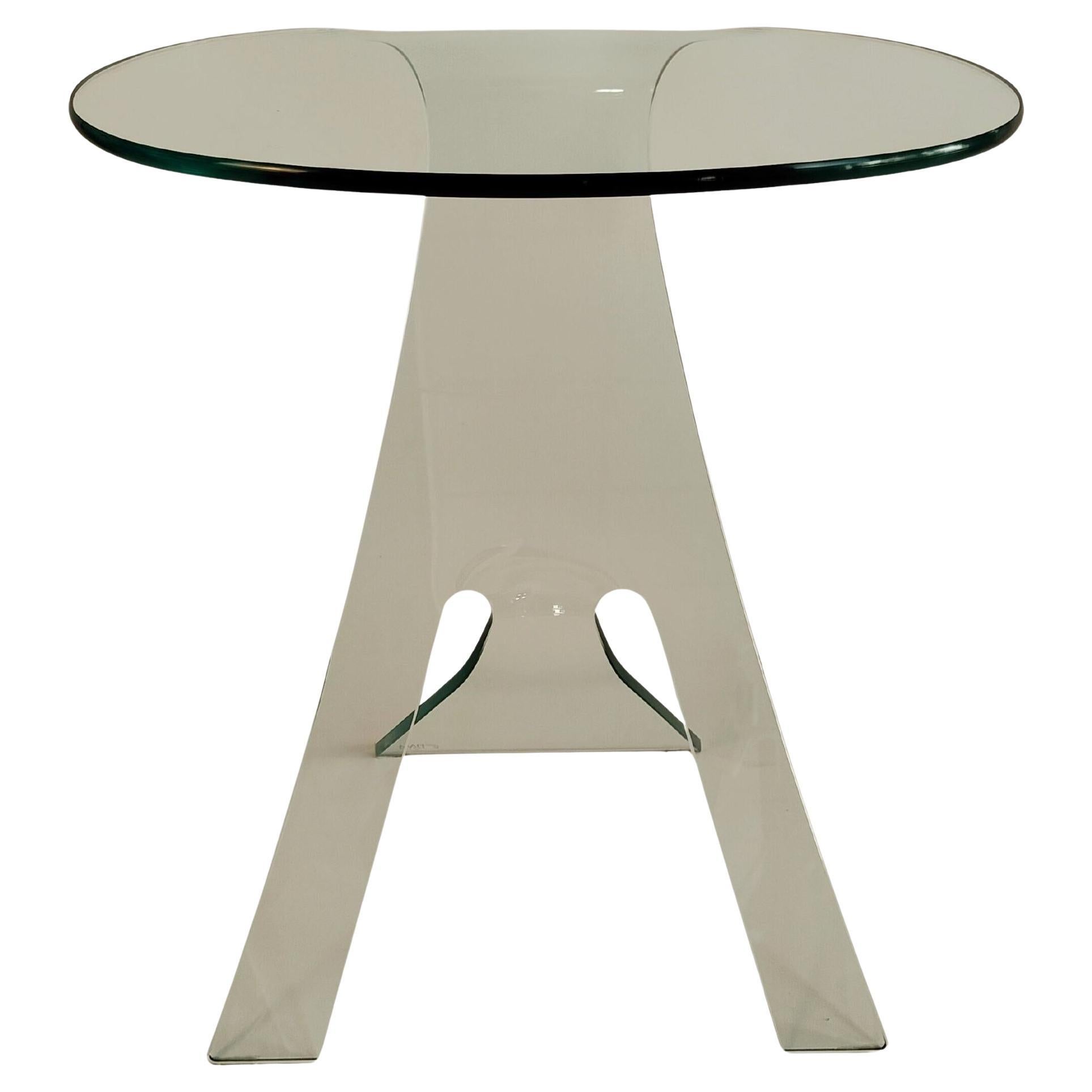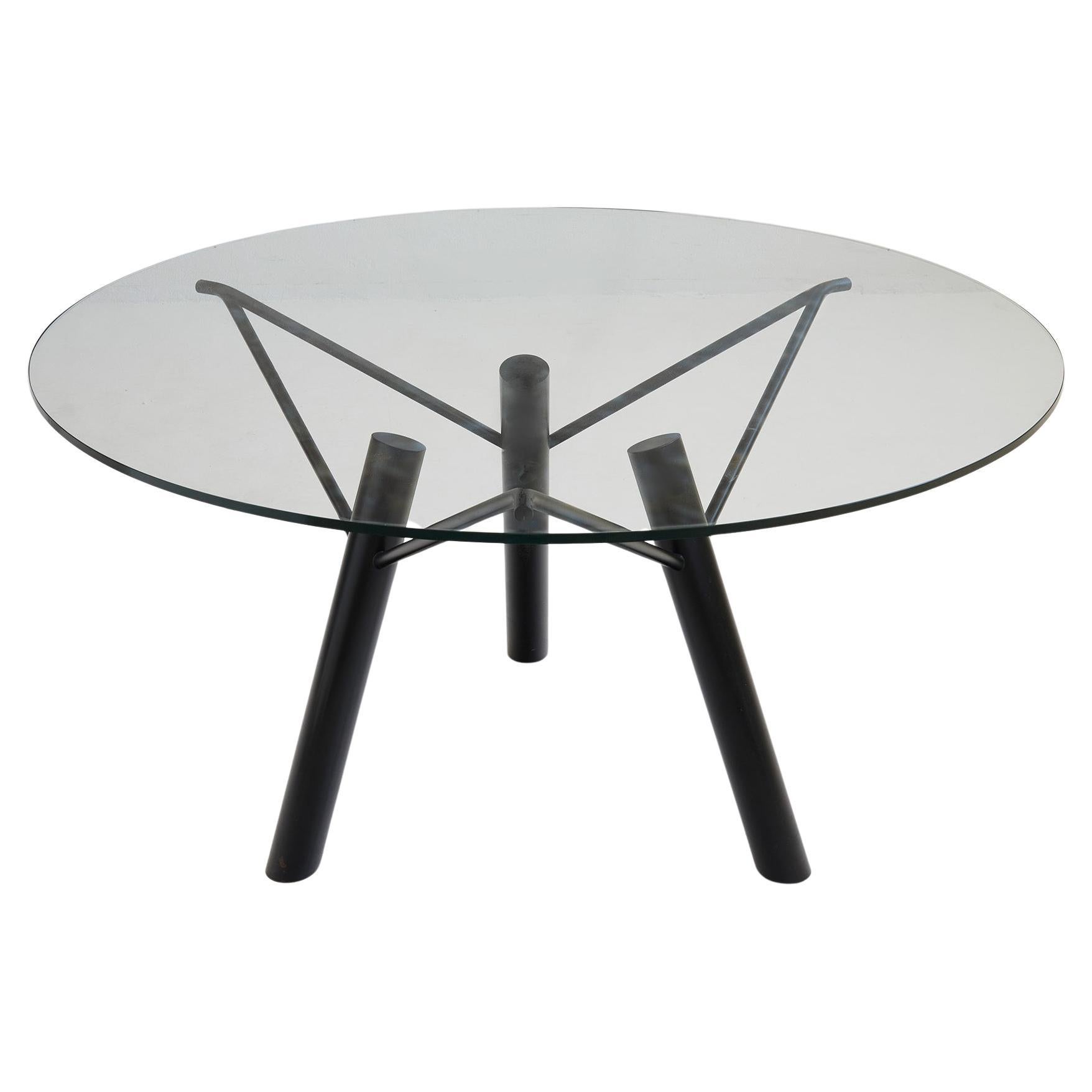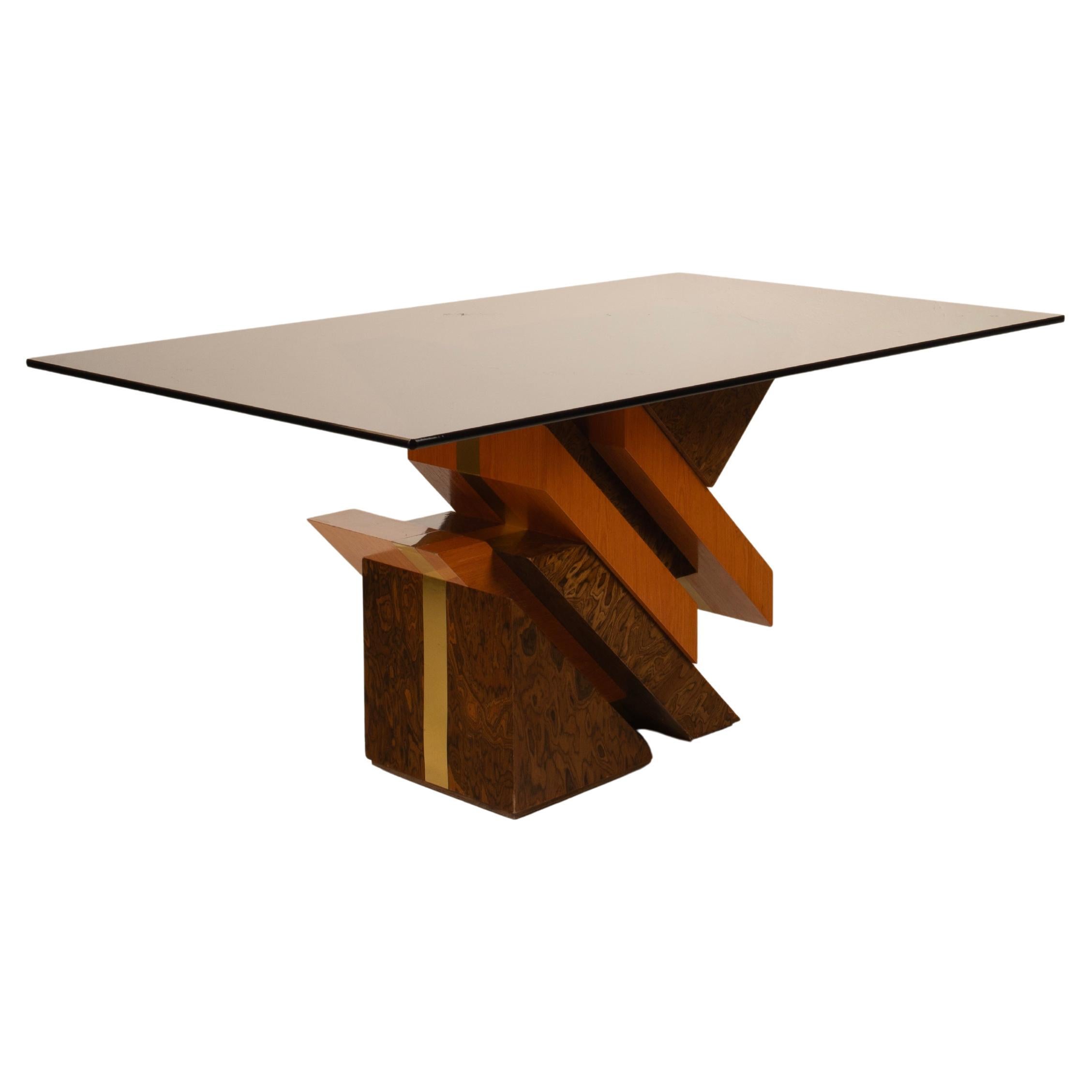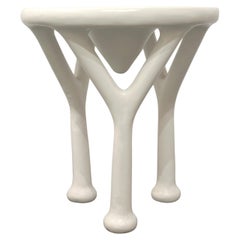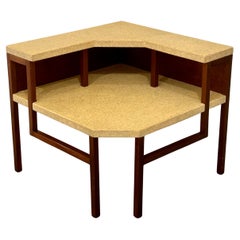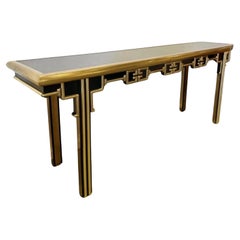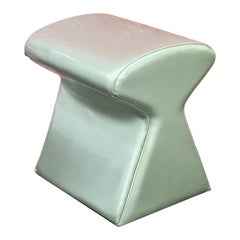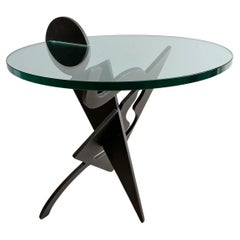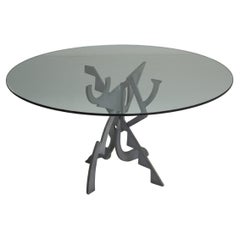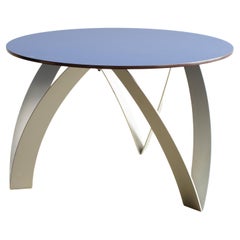Items Similar to Pucci De Rossi for H Dolin Stuart Signed Battista Occasional Table, 1987
Video Loading
Want more images or videos?
Request additional images or videos from the seller
1 of 16
Pucci De Rossi for H Dolin Stuart Signed Battista Occasional Table, 1987
$2,800
£2,132.20
€2,434.83
CA$3,934.35
A$4,316.73
CHF 2,273.84
MX$51,352.02
NOK 29,127.67
SEK 26,597.54
DKK 18,190.56
About the Item
Pucci De Rossi for H Dolin Stuart Signed Battista Occasional Table, 1987
A delightful postmodern sculptural side table with an interlocking charcoal color metal base with glass top by Italian-born, Paris-based designer and artist Pucci de Rossi. Signed and dated 1987 at the base.
The. table measures 28" high x 23-1/2" wide x 22" deep overall. The glass top is 3/4' thick and measures 22" diameter. The glass top surface is 24-3/8" high.
There are some light scratches in the glass that are not distracting when viewed at a normal distance. There is a chip at the edge of the glass that presents as green but is hidden where the glass attaches under the frame so it is not seen. Otherwise, light scratches as expected in an item of this age, See photos for full condition. In rather remarkable condition for its vintage.
Among the army of designers from the 1980s and ’90s plucked from the archive in recent years — Ettore Sottsass, Nathalie du Pasquier, and their Memphis cohort, to name a few — there are still many that remain ripe for rediscovery. Our latest find is Pucci de Rossi, the Italian-born artist and designer who intrigued and confused the Parisian design world with his Brutti Mobili (Ugly Furniture). A clear predecessor to a whole cohort of artist-designers working today — think Misha Kahn’s mixed media chimeras — Pucci de Rossi didn’t invent the concept of functional art, but his work from the 1970s to 1990s certainly laid some groundwork.
Born in the Northern Italian city of Verona, Pucci was a tinkerer at heart. The trajectory of his practice simply followed what kind of materials were available to him at the time. In the early days, under the tutelage of American sculptor Brooks Walker, he worked with found objects, gathering old furnishings and discarded objects to create Frankenstein-like medleys inspired by the Surrealist paintings of Dalí and De Chirico at his home on the banks of the Adige river. “Pucci began his artistic life before the arrival of Postmodern design,” writes Nancy Huston in a monograph dedicated to his work, “at a time when no one raised the problems of the relationship between artists and artisans, and the word ‘design’ had not yet undergone the inflation that we know today.”
A contemporary of the Memphis movement, he held Ettore Sottsass and his ilk in high regard, but, recalls his widow, gallerist Mathilde Baralhé: “Pucci did not define himself as a designer but more as a visual artist, he designed his own objects and very rarely worked for serialization. He was therefore not constrained by any technical specifications and could let his imagination run wild. He was a creator of forms in space which kept a function to his creations. Pucci was a sculptor who played with furniture, shapes, materials and styles.”
In the 1970s, Pucci left Vicenza and moved to Paris with his first wife, the French writer and artist Laure Vernière. Arriving in the capital signaled a creative boom time for Pucci. From his flat in the Bastille district, he would scour the streets collecting detritus from the artisans and craftspeople that populated the neighborhood, which he would then transform into his infinitely kinetic assemblages: “Zinc torn off the roof by the roofers, abandoned furniture, debris of all sorts could be found on the sidewalks. All these materials, tools, bistro awnings, old signs, ordinary wood, wire, plastic… were a gold mine for me… I could find everything in the neighborhood. After, came the idea,” he once said.
In the monograph, Huston describes these amalgams as anthropomorphic furniture. “The seats can’t stand still,” she writes. “Structures are crossed by fluid forms; struck by a cramp, a Chippendale leg becomes taut, its lion’s claws have dropped their ball. The seats become animated, their backs, their legs and their arms start to move. An Art Nouveau curve balances a molding with a right angle, improbable compartments with their knobs act as the left arm. Under the undulating seat are four disparate legs: a baroque scroll, a baluster and two geometric volumes. Asymmetrical, dislocated, lop-sided, the monster leaning on its crutch seems to raise its shoulder to start a burlesque dance or to flee, like Dr. Frankenstein’s creature or the furniture of Maupassant’s short story.”
Despite his prolificacy, it wasn’t until the mid-80s that Pucci could be tacked on to a coherent design movement. As his profile grew, he became known as the continental answer to the group called ‘The London Scrapdealers’ — an ad hoc movement made up of André Dubreuil, Tom Dixon, Mark Brazier Jones and Nick Jones who similarly employed found objects and contorted junk metal in their work. It was a mode of working that was unstudied and untaught, a reaction to the 1980s chrome-plated minimalism. “People were fed up with the minimal, they wanted curves and what they liked was the salvaging aspect, messed up, Arts & Crafts, to use the English term. We didn’t do drawings, we executed spontaneously,” Dubreuil said of the early Postmodernists. Finally, the style Pucci had been nurturing for decades was having a moment.
It was around this time that Pucci began working with Paris gallery Néotu, where he would produce a succession of collections in his proto-Nickelodeon aesthetic. Distorted furniture inspired by Dali (Hommage à Dalí, 1989), deconstructivist-style three-dimensional collages in metal and wood (Introibo ad altare dei, 1987) lamps spliced with shards of glass (Le Gardien du trésor, 1985), undulating plywood monoliths (Trois Fois rien,1991) and steampunk-like assemblages of wooden artifacts gleaned from forgotten chairs (Remake, 1993) all became examples of Pucci’s dogged eclecticism.
Paris also introduced Pucci to the kind of patrons who would allow his creative impulses to run free. The most influential among them was auctioneer Jean-Claude Binoche, known for his contemporary art and design sales, who commissioned Pucci to design the dining room and office in his Paris home, and later on, his sprawling Palazzo in Venice, which would become the most fully realized expression of Pucci’s idiosyncratic melding of art and design. A built-in sleigh bed formed in the shape of baroque scrolls, hand-painted technicolor murals on the building’s ancient rafters and furniture plucked from Pucci’s various collections over the years made up the extravagantly bizarre Venetian home.
“A man apart, gifted with overflowing ingenuity and inventiveness. It was not always easy to follow his thoughts every day, he was always thinking about the meaning of things, of life, of himself,” recalls Mathilde, who lived with Pucci at his Bastille apartment until he passed away in 2013.
Of his legacy, she writes: “The object that reflects this feeling is the J.A.R. mirror (Jamais Assez De Reflection/Never Enough Reflection), on one side a mirror, on the other a self-portrait. But unlike many other artists, Pucci was not self-centered, he was very available with his friends and relatives. He was very sensitive to people. He could be light and deep at the same time. He followed the impulses of his heart. But he was also a bon vivant who liked to party. What I liked about him was his humor, his mischievousness and the offbeat vision he had of the world: ‘I have to constantly change the reality that surrounds me, my work is an example of this and it is perhaps the way of expressing myself that suits me best’ [he once said]. Living with Pucci was like living a daydream. He was an everyday poet.”
Source: Sight Unseen
- Creator:Pucci De Rossi (Designer)
- Dimensions:Height: 28 in (71.12 cm)Width: 23.5 in (59.69 cm)Depth: 22 in (55.88 cm)
- Style:Post-Modern (Of the Period)
- Materials and Techniques:
- Place of Origin:
- Period:1980-1989
- Date of Manufacture:1987
- Condition:Wear consistent with age and use. There are some light scratches in the glass that are not distracting when viewed at a normal distance. There is a chip at the edge of the glass that presents as green and but is hidden where the glass attaches under the frame.
- Seller Location:Cathedral City, CA
- Reference Number:Seller: OC98651stDibs: LU8352245433332
About the Seller
5.0
Vetted Professional Seller
Every seller passes strict standards for authenticity and reliability
Established in 2000
1stDibs seller since 2023
24 sales on 1stDibs
Typical response time: <1 hour
- ShippingRetrieving quote...Shipping from: Cathedral City, CA
- Return Policy
More From This Seller
View AllJohn Dickinson Lacquered Y Table, ca 1970s
By John Dickinson
Located in Cathedral City, CA
John Dickinson Lacquered Y Table, ca 1970s
This is a rare Y-table (model 118) in lacquered resin, designed by John Dickinson. This is a special table and would fit in a variety of d...
Category
Vintage 1970s American Organic Modern Side Tables
Materials
Resin, Lacquer
Paul Frankl for Johnson Furniture Cork and Mahogany Corner Table, ca 1951
By Paul Frankl, Johnson Furniture Company
Located in Cathedral City, CA
Paul Frankl for Johnson Furniture Cork and Mahogany Corner Table, ca 1951
Unique large corner table that would be perfect with two larger mid-century sofas set in a L-shape arrangem...
Category
Mid-20th Century American Mid-Century Modern End Tables
Materials
Mahogany, Cork
Mastercraft USA Elegant Black Lacquer and Brass Console, ca 1970s
By Maitland Smith
Located in Cathedral City, CA
Mastercraft USA Elegant Black Lacquer and Brass Console, ca 1970s
Stunning and long Mastercraft black lacquer and brass console table with Greek key motif. This is an uncommon piec...
Category
Vintage 1970s American Hollywood Regency Console Tables
Materials
Brass
Karim Rashid Silver Vinyl Shroom Stool for IDEE Limited Edition Signed Numbered
By Idée Japan, Karim Rashid
Located in Cathedral City, CA
Karim Rashid Shroom Stool designed for IDEE, Japan in 1998. This silver vinyl version was a limited edition and is signed and numbered #4/57 on the IDEE labeled fabric on the bottom of the stool. It was part of the TOTEM Design collection; TOTEM - The Objects That Evoke Meaning - was a a progressive and influential retail design gallery in Manhattan operating between 1994-2004 that represented cutting edge modern design of the period.
Overall the stool is on good condition with a couple small tears, minor dents and scuffs to the vinyl, and wear as shown in the detail photos.
The stool measures 18" high x 16 ½" wide x 14" deep.
Karim Rashid (born 1960) is an Egyptian-born and Canadian raised industrial designer. His designs include luxury goods, furniture, lighting, surface design, brand identity and packaging. Time magazine has described him as the "most famous industrial designer in all the Americas" and the "Prince of Plastic". He is based in New York City, as well as Belgrade, Miami and India.
Rashid's work is featured in 20 permanent collections. His pieces are exhibited in museums worldwide, including the MoMA, Centre Pompidou, and SFMOMA. He is known for designs such as the "Garbo" waste can and "Oh Chair...
Category
1990s Japanese Futurist Stools
Materials
Upholstery, Synthetic, Foam, PVC
Yasha Heifetz Rotaflex Oversized Table Lamp, ca 1950s
By Heifetz, Heifetz Rotaflex, Yasha Heifetz
Located in Cathedral City, CA
Yasha Heifetz Rotaflex Table Lamp, ca 1950s
A rare version of the Heifetz Rotaflex lamp featuring a spun plastic cord shade that rests inside a pierced brass receptacle that mounts ...
Category
Mid-20th Century American Mid-Century Modern Table Lamps
Materials
Metal, Brass
Lee Rosen Design Technics Incised & Slip Decorated Abstract Design Vase ca 1950s
By Lee Rosen, Design Technics
Located in Cathedral City, CA
Lee Rosen for Design Technics Incised and Slip Decorated Abstract Design Vase, ca 1950s
This is a gorgeous and unique Design Technics vase by Lee Rosen that features a biomorphic sh...
Category
Mid-20th Century American Mid-Century Modern Vases
Materials
Ceramic, Pottery
You May Also Like
Pucci De Rossi (1947-2013) "Battista" Occasional Table
By Pucci De Rossi
Located in West Palm Beach, FL
Pucci De Rossi
(1947-2013)
Occasional table with two interlocking panels of ⅝” thick steel cut into abstract forms with one piece of 3/4" x24" new glass that slides into the table Be...
Category
Vintage 1980s American Mid-Century Modern Side Tables
Materials
Cut Steel
Table Sculpture Pucci De Rossi "Tristan and Isolde" H. Dolin Stuart France 1987
By Pucci De Rossi
Located in Catania, IT
PUCCI DE ROSSI (1947-2013) & H. DOLIN STUART
"Tristan and Isolde" table, designed in 1978, produced in 1987, gray lacquered steel frame and glass top.
Neotu Edition
H 73.5 × Ø 130 cm...
Category
Vintage 1980s French Modern Tables
Materials
Iron
Kioko side table De Pas, D'urbino, Lomazzi postmodern 80s style
By Zanotta, Gionathan de Pas & Donato D’Urbino & Paolo Lomazzi
Located in Shibuya-ku, Tokyo
Kioko side table designed by De Pas, D'urbino, Lomazzi. This table was published in the early 90s. Legs are probably aluminum. Table top is painted wood.
To Europe and Asia buyers....
Category
Vintage 1980s Italian Post-Modern Side Tables
Materials
Steel
FIAM Italia "Grillo" coffee table by Vittorio Livi, curved crystal, Italy, 1980
By FIAM, Vittorio Livi
Located in Vicenza, VI
Grillo coffee table in curved glass designed by Vittorio Livi for FIAM Italia in c. 1980s. A single sheet of curved glass measuring 62x53x39 cm and 12 mm thick. Modern design charact...
Category
Vintage 1980s Italian Post-Modern End Tables
Materials
Crystal
$1,148 Sale Price
37% Off
"Orrido Canyon" dining table by Mireille Rivier and Paolo Pallucco, Italie 1987
By Paolo Pallucco & Mireille Rivier, Pallucco
Located in Renens, CH
"Orrido Canyon" dining table by Mireille Rivier and Paolo Pallucco, Italie 1987
It features a sculpturally shaped base with three cylindrical angled legs. A top the round tempered g...
Category
Vintage 1980s Italian Post-Modern Dining Room Tables
Materials
Metal
Postmodern Sculptural Table by Poggioli, Italy, 1970s
Located in Conversano, IT
This extraordinary sculptural table, made in Italy by Poggioli in the 1970s, represents one of the boldest expressions of Italian postmodern decorative design. The piece stands out f...
Category
Vintage 1970s Italian Hollywood Regency Dining Room Tables
Materials
Brass
More Ways To Browse
Vintage Awning
Tresor Vintage
Arts And Crafts Day Bed
Bistro Sign
Wall Tapestry White
Agate Slab
Angel Wall Sculptures
Antique Brass Horns
Antique Bugle
Antique Cast Iron Horse
Antique Catholic Art
Antique Desk Hinges
Antique Equestrian Prints
Antique Foyer Furniture
Antique Ironstone Bowls
Antique Meissen Bowls
Antique Plaster Wall Sculpture
Austrian Rococo Furniture
